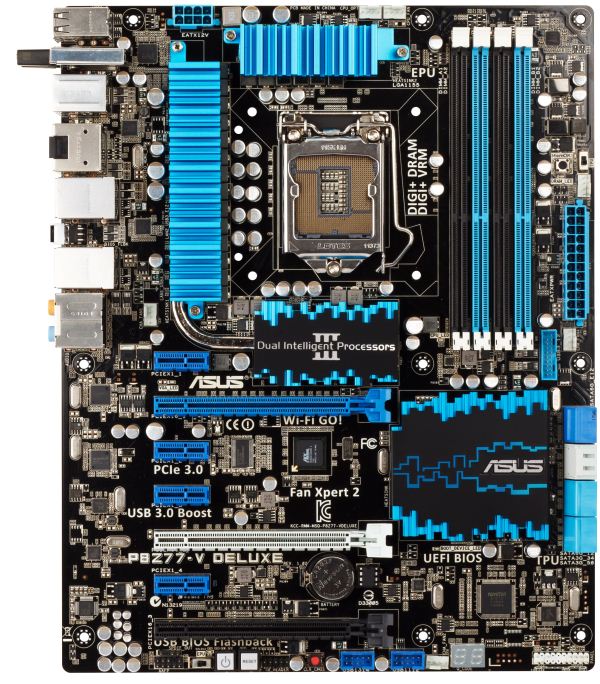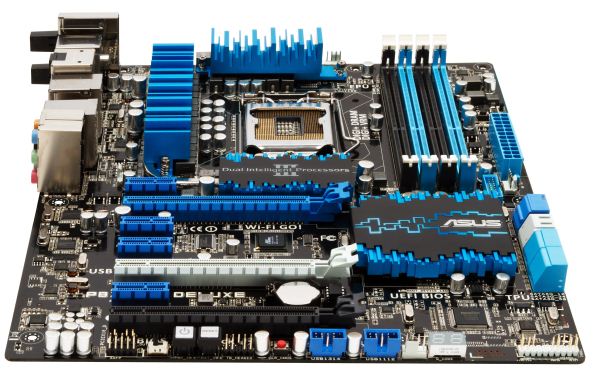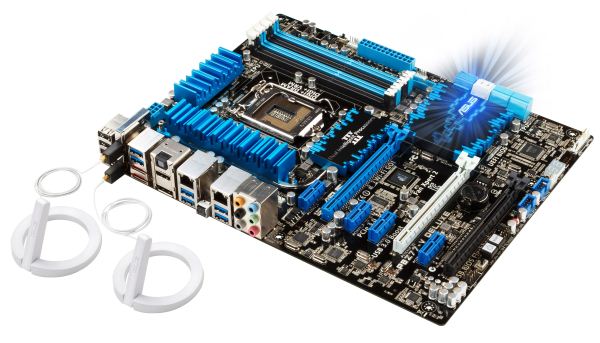Intel Z77 Panther Point Chipset and Motherboard Preview – ASRock, ASUS, Gigabyte, MSI, ECS and Biostar
by Ian Cutress on April 8, 2012 12:00 AM EST- Posted in
- Motherboards
- Intel
- Biostar
- MSI
- Gigabyte
- ASRock
- Asus
- Ivy Bridge
- ECS
- Z77
ASUS P8Z77-V Deluxe—Visual Inspection
In the next notch up in the channel board segregation, ASUS sell the Deluxe. This will be the first ASUS Deluxe board we have reviewed at AnandTech since the Llano mini-ITX F1A75-I Deluxe last year. In comparison to the P8Z77-V Pro, the Deluxe features several upgrades in terms of functionality and comfort.
The first to note is the increased power delivery to the CPU—this time in the form of a 16 + 4 phase power delivery. As a result, the VRM heatsinks to the left of the CPU are directly connected via a heatpipe to another heatsink below the socket. Also on board are the ‘enthusiast’ power/reset buttons and two-digit debug that we did not see on the Pro, and the use of dual NICs on the I/O, in the form of an Intel 82579V and a Realtek 8111F.
Due to the positioning off the heatsinks on the Deluxe compared to the Pro, the socket area seems a bit smaller (for example, the left hand heatsink is moved further in towards the socket), meaning that big air coolers may have a tougher time if they do not fit into Intel’s socket specification. Around the socket itself, we still have access to five fan headers—two 4-pin on the top of the board, one 4-pin to the bottom left of the main VRM heatsink, and one 4-pin either side of the 24-pin ATX power connector. A sixth fan header on board is found at the bottom next to the two-digit debug output.
Above the main power connector on the right hand side are the MemOK button and the TPU switch (for a fast automatic overclock). Below it is a USB 3.0 header, and a set of eight SATA ports. Similar to the ASUS Pro, we have four SATA 3 Gbps from the PCH, two SATA 6 Gbps also from the PCH, and two SATA 3 Gbps from a different controller—the Marvell 9128. This allows RAID 0/1 on these two SATA 6 Gbps ports.
The south side of the board still contains front panel headers and USB 2.0 ports, but also comes with the aforementioned power/reset buttons and two-digit debug display. We also find a ClearCMOS button on board, useful for overclockers. There is also a header labelled 'TB_Header', which should mean Thunderbolt, but there is no mention of it in the specifications. I will have to check up on this.
Update: The TB_Header is actually for a new Thunderbolt add-in card that ASUS will be selling. This is aimed to go into the x4 slot and provide Thunderbolt connectivity. MSRP will be around the $30-$40 mark so I am told.
In terms of the PCIe, we have a little bit of confusion. While in the middle between the PCIe is a PLX chip, it is not the PLX PXE 8747 chip that increases PCIe lane count. The one on the Deluxe is just to provide extra data transfer access for the various controllers on the motherboard. This means that the third full length PCIe in black is like other boards in that this is a PCIe 2.0 x4, non-GPU port. So from the top, we have a PCIe x1, x16 (x8 in Multi-GPU), x1, x1, x8, x1, x4. As a result, there is no PCIe to PCI bridge chip on this high-end model for PCI slots.
For the back panel, ASUS have done a juggling act deciding what to include. On the far left is a set of four USB 2.0 ports (black), a mini-PCIe WiFi + Bluetooth module, two USB 3.0 (blue), two eSATA, optical SPDIF output, HDMI output, DisplayPort, dual gigabit Ethernet, another four USB 3.0 ports (blue), a BIOS flashback button, and audio outputs. So in the name of a double NIC and 10 total USB ports on the back panel, we have lost D-Sub, DVI, IEEE1394 and a ClearCMOS button.
Board Features
| ASUS P8Z77-V Deluxe | |
| Size | ATX |
| CPU Interface | LGA-1155 |
| Chipset | Intel Z77 |
| Power Delivery | 16 + 4 |
| Memory Slots |
Four DDR3 DIMM slots supporting up to 32 GB Up to Dual Channel |
| Video Outputs | DisplayPort, HDMI |
| Onboard LAN |
Intel 82579V Realtek 8111F |
| Onboard Audio | Realtek ALC898 |
| Expansion Slots |
2 x PCIe x16 Gen3 (x16, x8/8) 1 x PCIe x16 Gen2 (x4) 4 x PCIe x1 Gen2 |
| Onboard SATA/RAID |
2 x SATA 6 Gbps (PCH), Support for RAID 0, 1, 5, 10 2 x SATA 6 Gbps (Marvell PCIe 9128), RAID 0, 1 4 x SATA 3 Gbps (PCH), Support for RAID 0, 1, 5, 10 2 x eSATA 6 Gbps (ASMedia) |
| USB |
Four USB 3.0 at rear (2 PCH, 2 ASMedia) Two USB 3.0 headers on board (PCH, ASMedia) Eight USB 2.0 (4 back panel, 4 on board) |
| Onboard |
4 x SATA 6 Gbps 4 x SATA 3 Gbps 1 x USB 3.0 Headers 2 x USB 2.0 Headers 6 x Fan Headers 1 x SPDIF Header 1 x Front Panel Audio Header 1 x TB Header MemOK! Button TPU/EPU Switches USB Flashback Button Power/Reset Buttons |
| Power Connectors |
1 x 24-pin ATX connector 1 x 8-pin 12V connector |
| Fan Headers |
1 x CPU Fan Header (4-pin) 4 x CHA Fan Headers 1 x OPT Fan Header |
| IO Panel |
2 x eSATA 6 Gbps 1 x DisplayPort 1 x HDMI 1.4a 2 x Gigabit Ethernet 6 x USB 3.0 4 x USB 2.0 1 x Optical SPDIF Audio Outputs Bluetooth V4.0 Wifi USB Flashback |
| Warranty Period | 3 Years |
| Product Page | Link |
Obviously one of the main selling points of the board is the onboard WiFi and Intel NIC (alongside a Realtek NIC).














145 Comments
View All Comments
Zoomer - Tuesday, April 10, 2012 - link
So when is AMD buying them out and integrating this in their gfx cards / platform?neo55 - Sunday, April 8, 2012 - link
Will Z77 support two or three monitors simultaneously?GreenEnergy - Sunday, April 8, 2012 - link
You mean from the Ivy Bridge IGP?Well depends. (Its the same btw for H77, Z75 and Z77 etc.). You need to have 2 displayport if I remember correctly. So if you got for example DVI, HDMI and DP. Then 2 screens only. If you got DVI, DP, DP then 3. Or if you daisychain the DP?
dubyadubya - Sunday, April 8, 2012 - link
Listing fan header count and layout is useless if you do not test the functionality. Do they report RPM? Can they control fan speed? Does the fan control work with Speedfan etc. or only the software from the motherboard manufacturer? Several years ago many people including myself brought this to Anandtech's attention. At the time Anandtech stated they would include this missing info which they did. Trouble is the info was only included in one or two reviews before it was dropped. When I purchase a new motherboard I want to know this info. I have spent many hours searching for this info for each new build as most manufactures do not give detailed info even in the motherboard manual.IMO if a fan header exists it must have full functionality. If not the header should not be on the board. Motherboard manufactures need to pull their heads out of their asses. If Anandtech reported this info in reviews and gave negative reviews on boards with poor fan support the manufacturers would get the hint.
Nje - Sunday, April 8, 2012 - link
Yeah I would love to know this, particularly if the fan headers can control 3 pin fans as well (ie vary the voltage).ASUSTechMKT - Monday, April 9, 2012 - link
Primary CPU headers ( CPU and CPU OPT are fully controllable for 4 pin ) as the majority of CPU coolers are PWM for chassis headers ( 1-4 all allow for 3 pin and 4 pin fan control ).Zoomer - Tuesday, April 10, 2012 - link
Asus, can they be used with speedfan or is it BIOS/Asus software only?ASUSTechMKT - Monday, April 9, 2012 - link
This has been noted in the last couple of reviews. Specifically for ASUS we have spent considerable time putting quality fan controls on our boards all headers allow for 3 presets as well as min and max rotation and target temperatures. In addition with our software for this generation we offer full calibration per each header that can sense the min and max rotation and provide this information as well as sync this data to the profiles. Overall it is quite extensive make sure to check out our videos coming up which shows it in great depth.Arbie - Monday, April 9, 2012 - link
@dubyadubya - Look on the bright side: at least one manufacturer (Asus) takes fans seriously, and at least one reviewer (Anandtech) is even mentionng the fact.I have the same wants as you do, and have made the same requests, but be reasonable. These aren't full motherboard reviews! They don't even have the boards operable, much less any hands-on time with BIOS details.
And when they do have all that, a higher priority will be PCIe lanes and how many graphics cards can be stuffed in. That's because you can't run any modern games with only one board.
But then they might talk a little more about the fan controls... Let's hope. Again - be glad that even one vendor is paying attention and has included some controls to be talked about.
Cavalcade - Sunday, April 8, 2012 - link
With a slightly more than passing knowledge of rendering, and having spent a fair amount of time handling input in a game engine, I'm curious as to how Lucid came to the responsiveness numbers in the chart on page 3. The concept seems valid at first glance, but the numbers strike me as pure marketing fodder as opposed to solid and testable results.Also, this sort of technology seems far better suited to residing in the driver layer as opposed to yet another piece of middleware for PC gamers to contend with. We're already effectively blocked from the hardware, and forced to go through third-party graphics APIs (Direct3D/OpenGL).
Maybe it's a "you have to see it (feel it)" kind of thing, but from here you can color me skeptical.